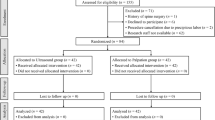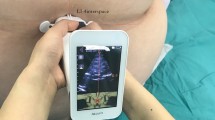Abstract
Palpation method is widely used in clinical practice to identify the puncture site during combined spinal-epidural (CSE) blocks. Tuffier’s line, is an anatomical landmark between two iliac crests (inter-cristal), which is widely used to identify the puncture site during CSE blocks is not always an indicator for specific vertebral level or inter-vertebral space. One hundred and Ten (110) women were scheduled for normal vaginal delivery and were randomized into two equal groups; palpation group and an ultrasound guided group to detect the efficacy of puncture ultrasound before CSE blocks to increase chances of successful CSE procedure on the first attempt and to reduce the number of attempts or punctures during insertion of CSE catheter. There were no significant differences between two studied groups regarding; maternal age, weight and height, while, there was a significant difference between two studied groups regarding; parity. Percentage of successful CSE procedure on the first attempt was significantly higher (67.27 %) in ultrasound compared to palpation group (40 %). Number of punctures (attempts) were significantly less in ultrasound (1.2 ± 0.6) compared to palpation group (2.3 ± 0.8) and the number of redirections was also significantly less in ultrasound (1.4 ± 0.5) compared to palpation group (2.8 ± 1.6). Although, time to identify puncture site was significantly longer in ultrasound compared to palpation group and total procedure time was longer in ultrasound (9.1 ± 1.5 min) compared to palpation group (6.2 ± 1.2 min), there was no significant difference between two studied groups regarding; time to identify puncture site and total procedure time. Two cases of dural puncture in palpation versus no cases in ultrasound group and two cases of intravascular catheter placement (one in each group), with no significant difference between two groups. Pre- puncture ultrasound guided epidural insertion before vaginal delivery, increases the chance of a successful CSE procedure on the first attempt and reduces the number of attempts during insertion of CSE catheter.
Similar content being viewed by others
References
Arzola C, Davies S, Rofaeel A, Carvalho JC. Ultrasound using the transverse approach to the lumbar spine provides reliable landmarks for labor epidurals. Anesth Analg. 2007;104:1188–92.
Clarita BM, Rafeek M, Arzola C, Balki M, Carvalho JCA. The intercristal line determined by palpation is not a reliable anatomical landmark for neuraxial anesthesia. Can J Anesth. 2011;58:262–6.
Vallejo MC, Phelps AL, Singh S, Orebaugh SL, Sah N. Ultrasound decreases the failed labor epidural rate in resident trainees. Int J Obstet Anesth. 2010;19(4):373–8.
Tran D, Kamani AA, Al-Attas E, Lessoway VA, Massey S, Rohling RN. Single-operator real-time ultrasoundguidance to aimand insert a lumbar epidural needle. Can J Anesth. 2010;57(4):313–21.
Carvalho JCA. Ultrasound-facilitated epidurals and spinals in obstetrics. Anesthesiol Clin. 2008;26(1):145–58.
Grau T, Leipold RW, Conradi R, Martin E, Motsch J. Efficacy of ultrasound imaging in obstetric epidural anesthesia. J Clin Anesth. 2002;14:169–75.
Grau T, Leipold RW, Fatehi S, Martin E, Motsch J. Real-time ultrasonic observation of combined spinal-epidural anaesthesia. Eur J Anaesthesiol. 2004;21:25–31.
Schnabel A, Schuster G, Ermert T, Eberhart LH, Metterlein T, Kranke P. Ultrasound guidance for neuraxial analgesia and Anesthesia in obstetrics: a quantitative systematic review. Ultraschall Med. 2012;33(7):32–7.
Balki M. Locating the epidural space in obstetric patients—ultrasound a useful tool: continuing professional development. Can J Anesth. 2010;57:1111–26.
Grau T, Leipold RW, Conradi R, Martin E, Motsch J. Ultrasound imaging facilitates localization of the epidural space during combined spinal and epidural anesthesia. Reg Anesth Pain Med. 2001;26:64–7.
Qian W, Cheng Y, Tian-long W. Ultrasound facilitates identification of combined spinal-epidural puncture in obese parturients. Chin Med J. 2012;125(21):3840–3.
Grau T, Leipold RW, Conradi R, Martin E. Ultrasound control for presumed difficult epidural puncture. Acta Anaesthesiol Scand. 2001;45:766–71.
Grau T, Leipold R, Conradi R, et al. Ultrasonography and peridural anesthesia. Technical possibilities and limitations of ultrasonic examination of the epidural space. J Anaesth. 2001;50:94–101.
Baraz R, Collis RE. The management of accidental dural puncture during labour epidural analgesia: a survey of UK practice. Anaesthesia. 2005;60:673–9.
Giebler RM, Scherer RU, Peters J. Incidence of neurologic complications related to thoracic epidural catheterization. Anesthesiology. 1997;86:55–63.
Lee Y, Tanaka M, Carvalho JC. Sonoanatomy of the lumbar spine in patients with previous unintentional dural punctures during labor epidurals. Reg Anesth Pain Med. 2008;33:266–70.
Gomar C, Fernandez C. Epidural analgesia-anaesthesia in obstetrics. Eur J Anaesthesiol. 2000;17:542–58.
Conflict of interest
No actual or potential conflict of interest exists in relation to this article.
Author information
Authors and Affiliations
Corresponding author
Rights and permissions
About this article
Cite this article
Nassar, M., Abdelazim, I.A. Pre-puncture ultrasound guided epidural insertion before vaginal delivery. J Clin Monit Comput 29, 573–577 (2015). https://doi.org/10.1007/s10877-014-9634-y
Received:
Accepted:
Published:
Issue Date:
DOI: https://doi.org/10.1007/s10877-014-9634-y




